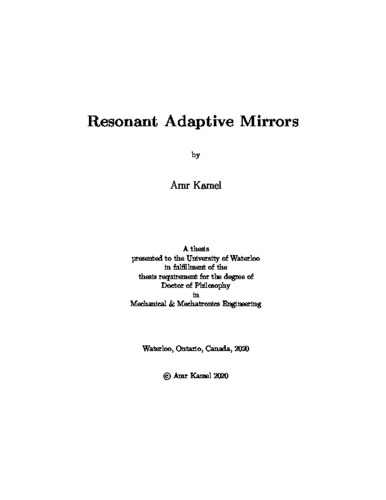| dc.description.abstract | Deformable mirrors (DMs) are integrated into adaptive optical (AO) systems to compensate
for wavefront aberrations. These aberrations degrade the image resolution of telescopes,
microscopes, ophthalmoscopes, and optical coherent tomographs. The objective of
the DM in these applications is to compensate for wavefront aberrations. Continuous and
segmented DMs utilize a variety of mechanisms such as electrostatic, piezoelectric, and
electromagnetic actuation. Micro-electromechanical systems (MEMS) DMs have the advantages
of low cost, low power consumption, and high electrode density. As the electrode
count increases, the possibility of the desired modes corresponding to the Zernike modes
appearing increases. However, the complexity of the static actuation also increases.
In ophthalmology, fth order Zernike modes are used to categorize the aberrations
induced by the human eye. These aberrations would degrade the image resolution of the
retina during laser scanning. Therefore, a dynamically continuous DMs were developed and
actuated at a natural frequency corresponding to the desired Zernike mode. The actuations
would drive the mirror plate to deform into the shape of the desired mode. Multiple
modes corresponding to low- and high-order Zernike modes were obtained. Resonant DMs
exploit the dynamic ampli cation available at natural frequency's in order to reduce voltage
and power requirements. This will also reduce the requirements for spatial control of
individual electrodes' voltage. However, the use of circular mirror plates to create the
electromechanical modes has led to the appearance of degenerate modes (pairs of almost
identical modes with closely spaced frequencies). Electrostatic elds were designed to
separate those modes and help break coupling between them. The elds employ selectively,
actuating some of the electrodes under the DM while grounding the rest. An AC voltage
was applied to selective scheme of electrodes in order to induced mode shapes that are
corresponding to the Zernike modes. This design relies on a new technique which uses
pulsed laser scanning instead of continuous laser scanning.
The proposed DM was designed and fabricated using a Micra-GEM fabrication process.
Simulations using the nite element method (FEM) software COMSOL were used
in order to determine the natural frequencies and mode shapes, and to separate degenerate
modes natural frequencies by applying electrostatic elds that increase the di erence
between them. Characterization of the DM was conducted using laser Doppler vibrometer
to identify the mode shapes and its natural frequencies experimentally. The stroke
measurements of the target DM were shown as a function of frequency and amplitude. In
addition, RMS error measurements were used as a comparison between DM modes and
there corresponding Zernike mode.
The aim of this research was to over come the in
uence function due to mechanical
coupling in the continuous DMs. In
uence function requires di erent voltages that apply
to electrode scheme. Therefore, static actuation of the DMs rely on a complex driving
circuits. Resonant DMs eliminate the e ect of the in
uence function by triggering the
mirror via its natural frequencies. They reduce the number of red electrode scheme by
applying single voltage to the electrodes. As a result, they reduce the complexity of the
driving circuits that require to control its shape. This research requires a new technique of
using a pulsed laser instead of a continuous laser for the proposed DM. This may lead to
manipulation of the optical laser signal using the mirror as a part of the signaling process.
This should be completed by synchronizing the frequencies of both the DM and the laser
to produce a high resolution image of the retina. | en |

